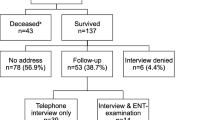Abstract
Objective
We planned a training course for trainees of different specialties with the aim of teaching the skills of a new procedure for performing percutaneous dilatational tracheostomy (PDT) with an ETView tracheoscopic ventilation tube instead of standard bronchoscopy in an ex vivo pig model.
Methods
The endotracheal tube, with a camera-embedded tip, was used as an alternative to standard bronchoscopy for visualization of patient airways. The procedure was performed on a home-made animal model. The participants were asked to perform PDT in three different sessions to improve their dexterity. The primary endpoint was the reduction of complications seen during the different sessions of the training course. The secondary endpoint was the satisfaction of the participants as assessed by an anonymous survey.
Results
Thirty-seven residents in anesthesiology and 7 in thoracic surgery in the first 2 years of their training and without any confidence with percutaneous tracheostomy participated in the study. Tracheal cuff lesions and impalement of the tracheal tube were the most observed complications, and were concentrated in the early sessions. A significant reduction in complications and operative time was seen during the ongoing sessions of the course. No lesions of the posterior tracheal wall and only a ring fracture occurred during the last session of the course. All participants were satisfied with the course.
Conclusions
Our course seems to confer the technical skills to perform percutaneous tracheostomy to trainees and instill confidence with the procedure. However, the experience acquired on a training course should be evaluated in clinical practice.




Similar content being viewed by others
References
Ciaglia P, Firsching R, Syniec C. Elective percutaneous dilatational tracheostomy: a new simple bedside procedure; preliminary report. Chest. 1985;87:715–9.
Fiorelli A, Carelli E, Angioletti D, Orsini A, D’Elia A, Torino A, Santini M, Ferraro F. A home-made animal model in comparison with a standard manikin for teaching percutaneous dilatational tracheostomy. Interact Cardiovasc Thorac Surg. 2015;20:248–53.
Fiorelli F, Ferraro F, Milione R, Scarumuzzi R, Imitazione P, Marulli L, Orsini A, Santini M. Percutaneous dilatational tracheostomy using a tracheoscopic ventilation tube in an experimental ex vivo animal model. Anaesth Intensive Care. 2016;44:371–5.
Norman G. Likert scales, levels of measurement and the “laws” of statistics. Adv Health Sci Educ Theory Pract. 2010;15:625–32.
Escarment J, Suppini A, Sallaberry M, Kaiser E, Cantais E, Palmier B, Quinot JF. Percutaneous tracheostomy by forceps dilation: report of 162 cases. Anaesthesia. 2000;55:125–30.
Massick DD, Powell DM, Price PD, Chang SL, Squires G, Forrest LA, Young DC. Quantification of the learning curve for percutaneous dilatational tracheotomy. Laryngoscope. 2000;110:222–8.
Zamponi E, Zanaboni S, Maestrone C, Della Corte F, Pelosi G. Learning curve in performing translaryngeal tracheostomy. Intensive Care Med. 2003;29:1031.
Cho J, Kang GH, Kim EC, Oh YM, Choi HJ, Im TH, Yang JH, Cho YS, Chung HS. Comparison of manikin versus porcine models in cricothyrotomy procedure training. Emerg Med J. 2008;25:732–4.
Terragni P, Mascia L, Faggiano C, Tenaglia T, Morello E, Succo G, Ranieri M, Brazzi L. A new training approach in endoscopic percutaneous tracheostomy using a simulation model based on biological tissue. Minerva Anestesiol. 2016;82:196–201.
Cipriano A, Mao ML, Hon HH, Vazquez D, Stawicki SP, Sharpe RP, Evans DC. An overview of complications associated with open and percutaneous tracheostomy procedures. Int J Crit Illn Inj Sci. 2015;5:179–88.
Al-Ansari MA, Hijazi MH. Clinical review: percutaneous dilatational tracheostomy. Crit Care. 2006;10:202.
Ferraro F, Marfella R, Esposito M, Petruzzi J, Torino A, d’Elia A, Santini M, Fiorelli A. Tracheal ring fracture secondary to percutaneous tracheostomy: is tracheal flaccidity a risk factor? J Cardiothorac Vasc Anesth. 2015;29:560–4.
Fiorelli A, Mazzone S, Di Crescenzo VG, Costa G, Del Prete A, Vicidomini G, Mazzone A, Santini M. A simple technique to control placement of Dumon stent in subglottic tracheal stenosis. Interact Cardiovasc Thorac Surg. 2014;18:390–2.
Author information
Authors and Affiliations
Corresponding author
About this article
Cite this article
Fiorelli, A., Ferraro, F., Frongillo, E. et al. Percutaneous dilatational tracheostomy using the ETView Tracheoscopic Ventilation Tube®: a teaching course in a pig model . J Anesth 31, 751–757 (2017). https://doi.org/10.1007/s00540-017-2394-3
Received:
Accepted:
Published:
Issue Date:
DOI: https://doi.org/10.1007/s00540-017-2394-3




